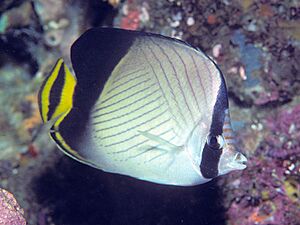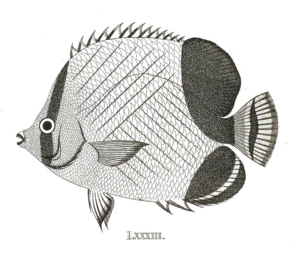Indian vagabond butterflyfish facts for kids
Quick facts for kids Indian vagabond butterflyfish |
|
|---|---|
 |
|
| Conservation status | |
| Scientific classification | |
| Genus: |
Chaetodon
|
| Species: |
decussatus
|
| Synonyms | |
|
|
The Indian vagabond butterflyfish (Chaetodon decussatus) is a colorful fish that lives in the ocean. People also call it the blackened butterflyfish or black-finned vagabond. It's a type of butterflyfish, which are known for their bright colors and patterns. You can find this fish in the Indo-West Pacific region. This includes places like the Maldives, India, Sri Lanka, and parts of Indonesia.
Contents
Discovering the Indian Vagabond Butterflyfish
This section tells you about this interesting fish. It covers what it looks like, where it lives, and how it behaves.
What Does it Look Like?
The Indian vagabond butterflyfish has a shiny, silvery-white body. It has cool diagonal grey lines across it. A wide black stripe goes right through its eyes. The back lower part of its body is mostly black. It also has bright yellow marks on its tail and on the fin underneath its body. This fish can grow up to 20 centimeters (almost 8 inches) long.
Where Does it Live?
You can find this fish in places with lots of coral reefs. They also live in areas with rubble and rocks. These fish prefer rich coral environments.
How Does it Behave?
Adult Indian vagabond butterflyfish usually swim in pairs. They are known to be monogamous, meaning they stay with one partner. Sometimes, they can be a bit territorial. This means they might protect their space from other fish of the same kind. Young fish, called juveniles, live by themselves.
What Does it Eat?
The Indian vagabond butterflyfish mostly eats algae. They also like to munch on coral polyps. These are tiny animals that make up coral reefs.
How Do They Reproduce?
These fish reproduce by laying eggs. This process is called being oviparous.
Who Discovered This Fish?
The Indian vagabond butterflyfish was first officially described in 1829. A French anatomist named Georges Cuvier (1769-1832) did this. He was a very important scientist. He said the fish came from "India."
Its Fishy Relatives
This fish belongs to a large group of butterflyfish called Rabdophorus. It is closely related to the threadfin butterflyfish (C. auriga). It is also related to the vagabond butterflyfish (C. vagabundus). These related fish often have a similar pattern. They have two areas with lines going up and down. However, their tail and back part colors can be very different.



